Carlos Eiras-Franco
University of A Coruña - Research Center on Information and Communication Technologies
Unsupervised Dynamic Feature Selection for Robust Latent Spaces in Vision Tasks
Oct 02, 2025Abstract:Latent representations are critical for the performance and robustness of machine learning models, as they encode the essential features of data in a compact and informative manner. However, in vision tasks, these representations are often affected by noisy or irrelevant features, which can degrade the model's performance and generalization capabilities. This paper presents a novel approach for enhancing latent representations using unsupervised Dynamic Feature Selection (DFS). For each instance, the proposed method identifies and removes misleading or redundant information in images, ensuring that only the most relevant features contribute to the latent space. By leveraging an unsupervised framework, our approach avoids reliance on labeled data, making it broadly applicable across various domains and datasets. Experiments conducted on image datasets demonstrate that models equipped with unsupervised DFS achieve significant improvements in generalization performance across various tasks, including clustering and image generation, while incurring a minimal increase in the computational cost.
Evaluate with the Inverse: Efficient Approximation of Latent Explanation Quality Distribution
Feb 21, 2025Abstract:Obtaining high-quality explanations of a model's output enables developers to identify and correct biases, align the system's behavior with human values, and ensure ethical compliance. Explainable Artificial Intelligence (XAI) practitioners rely on specific measures to gauge the quality of such explanations. These measures assess key attributes, such as how closely an explanation aligns with a model's decision process (faithfulness), how accurately it pinpoints the relevant input features (localization), and its consistency across different cases (robustness). Despite providing valuable information, these measures do not fully address a critical practitioner's concern: how does the quality of a given explanation compare to other potential explanations? Traditionally, the quality of an explanation has been assessed by comparing it to a randomly generated counterpart. This paper introduces an alternative: the Quality Gap Estimate (QGE). The QGE method offers a direct comparison to what can be viewed as the `inverse' explanation, one that conceptually represents the antithesis of the original explanation. Our extensive testing across multiple model architectures, datasets, and established quality metrics demonstrates that the QGE method is superior to the traditional approach. Furthermore, we show that QGE enhances the statistical reliability of these quality assessments. This advance represents a significant step toward a more insightful evaluation of explanations that enables a more effective inspection of a model's behavior.
Beyond RMSE and MAE: Introducing EAUC to unmask hidden bias and unfairness in dyadic regression models
Jan 19, 2024Abstract:Dyadic regression models, which predict real-valued outcomes for pairs of entities, are fundamental in many domains (e.g. predicting the rating of a user to a product in Recommender Systems) and promising and under exploration in many others (e.g. approximating the adequate dosage of a drug for a patient in personalized pharmacology). In this work, we demonstrate that non-uniformity in the observed value distributions of individual entities leads to severely biased predictions in state-of-the-art models, skewing predictions towards the average of observed past values for the entity and providing worse-than-random predictive power in eccentric yet equally important cases. We show that the usage of global error metrics like Root Mean Squared Error (RMSE) and Mean Absolute Error (MAE) is insufficient to capture this phenomenon, which we name eccentricity bias, and we introduce Eccentricity-Area Under the Curve (EAUC) as a new complementary metric that can quantify it in all studied models and datasets. We also prove the adequateness of EAUC by using naive de-biasing corrections to demonstrate that a lower model bias correlates with a lower EAUC and vice-versa. This work contributes a bias-aware evaluation of dyadic regression models to avoid potential unfairness and risks in critical real-world applications of such systems.
Sustainable Transparency in Recommender Systems: Bayesian Ranking of Images for Explainability
Jul 27, 2023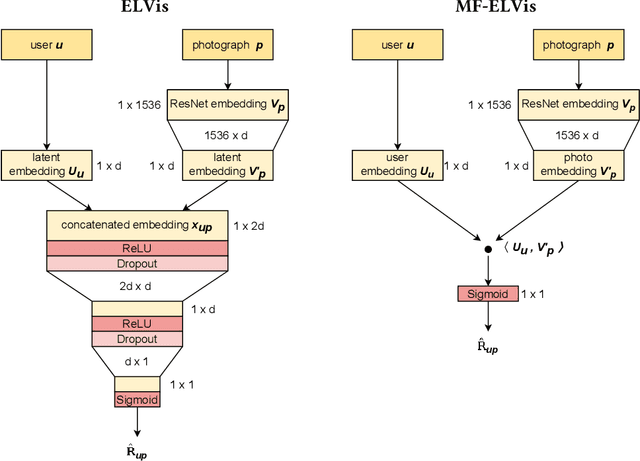

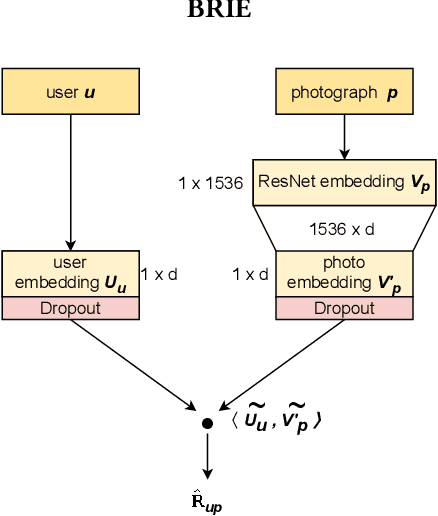
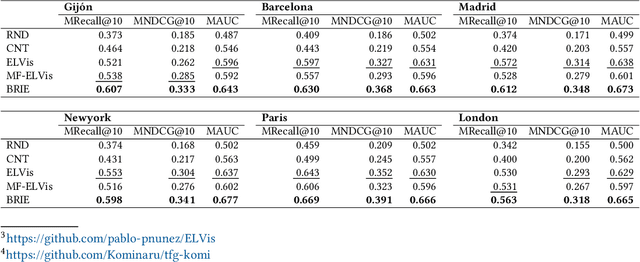
Abstract:Recommender Systems have become crucial in the modern world, commonly guiding users towards relevant content or products, and having a large influence over the decisions of users and citizens. However, ensuring transparency and user trust in these systems remains a challenge; personalized explanations have emerged as a solution, offering justifications for recommendations. Among the existing approaches for generating personalized explanations, using visual content created by the users is one particularly promising option, showing a potential to maximize transparency and user trust. Existing models for explaining recommendations in this context face limitations: sustainability has been a critical concern, as they often require substantial computational resources, leading to significant carbon emissions comparable to the Recommender Systems where they would be integrated. Moreover, most models employ surrogate learning goals that do not align with the objective of ranking the most effective personalized explanations for a given recommendation, leading to a suboptimal learning process and larger model sizes. To address these limitations, we present BRIE, a novel model designed to tackle the existing challenges by adopting a more adequate learning goal based on Bayesian Pairwise Ranking, enabling it to achieve consistently superior performance than state-of-the-art models in six real-world datasets, while exhibiting remarkable efficiency, emitting up to 75% less CO${_2}$ during training and inference with a model up to 64 times smaller than previous approaches.
Explanation Method for Anomaly Detection on Mixed Numerical and Categorical Spaces
Sep 09, 2022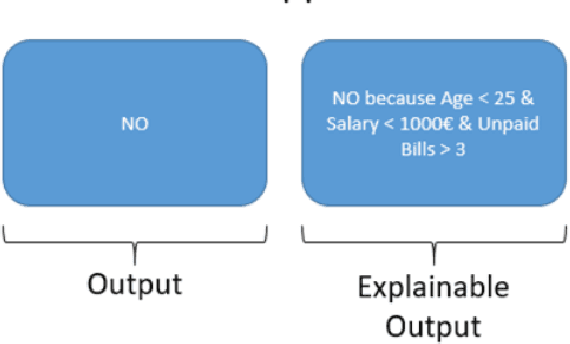
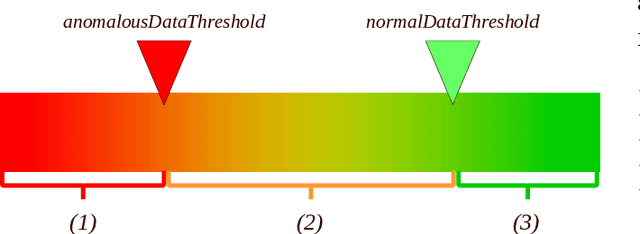
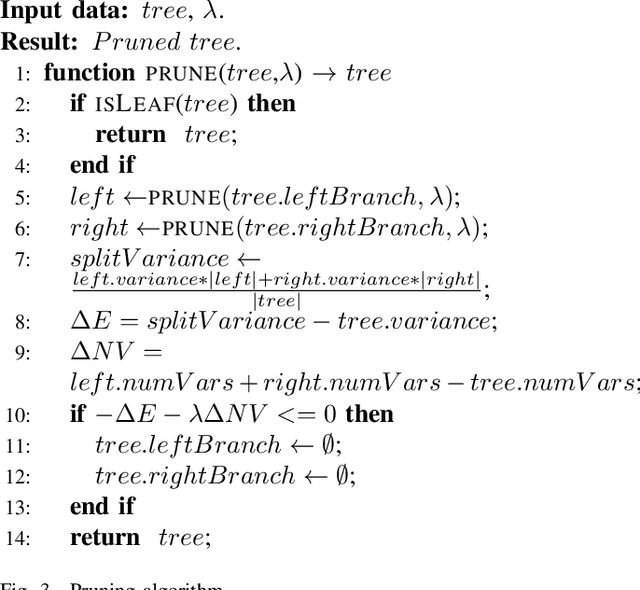
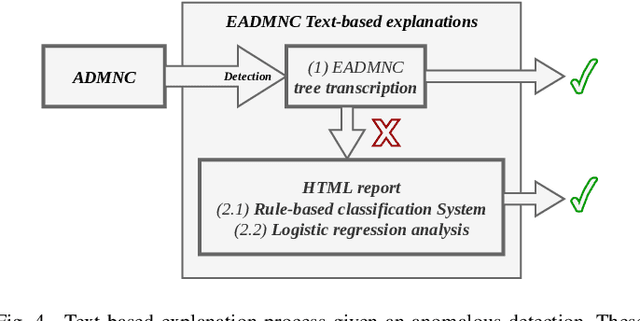
Abstract:Most proposals in the anomaly detection field focus exclusively on the detection stage, specially in the recent deep learning approaches. While providing highly accurate predictions, these models often lack transparency, acting as "black boxes". This criticism has grown to the point that explanation is now considered very relevant in terms of acceptability and reliability. In this paper, we addressed this issue by inspecting the ADMNC (Anomaly Detection on Mixed Numerical and Categorical Spaces) model, an existing very accurate although opaque anomaly detector capable to operate with both numerical and categorical inputs. This work presents the extension EADMNC (Explainable Anomaly Detection on Mixed Numerical and Categorical spaces), which adds explainability to the predictions obtained with the original model. We preserved the scalability of the original method thanks to the Apache Spark framework. EADMNC leverages the formulation of the previous ADMNC model to offer pre hoc and post hoc explainability, while maintaining the accuracy of the original architecture. We present a pre hoc model that globally explains the outputs by segmenting input data into homogeneous groups, described with only a few variables. We designed a graphical representation based on regression trees, which supervisors can inspect to understand the differences between normal and anomalous data. Our post hoc explanations consist of a text-based template method that locally provides textual arguments supporting each detection. We report experimental results on extensive real-world data, particularly in the domain of network intrusion detection. The usefulness of the explanations is assessed by theory analysis using expert knowledge in the network intrusion domain.
 Add to Chrome
Add to Chrome Add to Firefox
Add to Firefox Add to Edge
Add to Edge